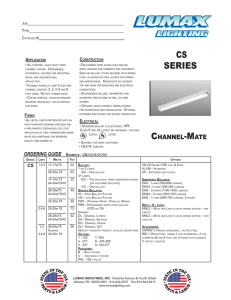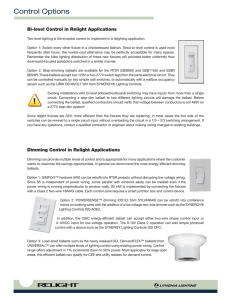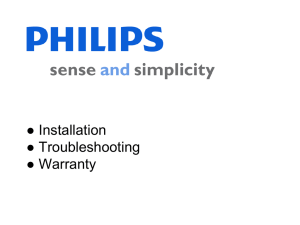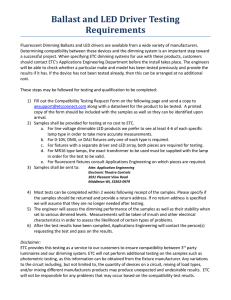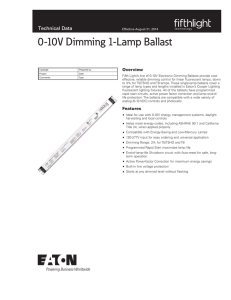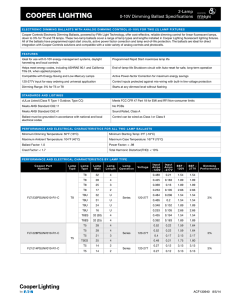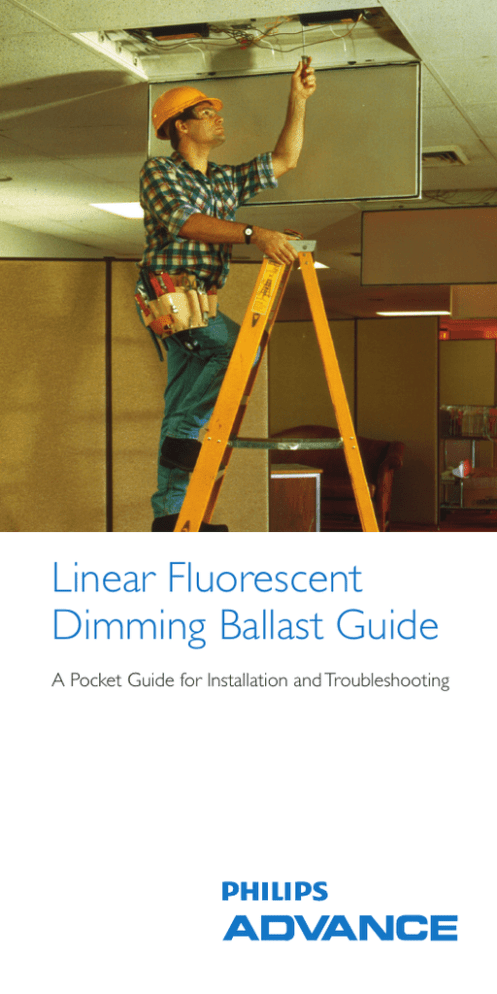
Linear Fluorescent
Dimming Ballast Guide
A Pocket Guide for Installation and Troubleshooting
Welcome
his pocket guide was created as a “quick reference”
T
to help you address some common issues with
dimming ballasts, both during the installation process
and troubleshooting problems in the field. For more
information regarding additional concerns with dimming
ballasts please contact our technical services
department at 1-800-372-3331, follow option 2.
Installation
In this section we will discuss three areas to be aware
of prior to installing your dimming ballast. They include:
fixture construction, wiring issues and usage of
proper sockets.
General Fixture Construction - Sagging
It is imperative that the minimum lamp spacing to the
fixture be maintained for the duration of the fixture life.
For linear lamps, the minimum spacing is 0.25”. T8
lamps must be within 0.75” from the ground plane and
T5 lamps within 0.25”. Issues resulting from fixtures
sagging must be corrected.
Symptoms to look for:
• Ballast channel cover touching the lamp
• Lamps bowed or bending
• Lamps extinguish in dim mode
• Lamps are turning black in the middle
(where the metal touches the glass)
• Inconsistent starting
• Variable light levels from lamp-to-lamp
in the fixture
When these symptoms are visible, contact the fixture
manufacturer, if you are unable to correct the issues in
the field.
2
Linear Fluorescent Dimming Ballasts Guide
Wiring Issues
Wiring in the ballast chamber is critical to the quality
of light and dimming consistency between lamps.
To minimize inconsistent dimming light levels and to
eliminate unpredictable lamp starting and lamp
dropout, the following guidelines must be followed:
• When ballasts are installed, all lead wires should
be kept as short as possible
• Output leads (wires from the ballast to the
lamp sockets) should not be bunched, twisted,
wrapped, or cable tied together.
• Input wires (power wires and control wires)
should not be bunched, twisted, wrapped, or
wire tied together with the output wires.
• Input and output wires should be routed on
opposite sides of the wire way channel as best
as possible.
Sockets
Rapid Start Socket
Instant Start Sockets
vs.
Shunted
Always make sure that dimming ballasts are connected
to rapids start sockets only. NEVER connect dimming
ballasts to an instant start or shunted sockets as this
will void the ballast warranty and most likely shorten
lamp life!
Dimming ballasts and lamps must be
replaced if they have been operated on instant
start or shunted sockets, since they have been
permanently damaged.
Installation
3
Troubleshooting
Wiring issues
One of the most common problems with dimming
ballasts is improper wiring to sockets, which usually
results in short lamp life.
Additional symptoms to look for:
• Severe end blackening
• Lamps extinguish at lowest dimming level
• Inconsistent / failure to start
• Lamp flickering / flashing / strobing
• Lamp striations (full wattage lamps)
• Short ballast Life
Output Wiring – Parallel Filaments
A common example of improper wiring when
connecting parallel lamp filaments is depicted below:
Incorrect Parallel Yellows
There are two ways to correct this situation
4
Correct Parallel Yellows (1 of 2)
Linear Fluorescent Dimming Ballasts Guide
Correct Parallel Yellows (2 of 2)
Output Wiring – Series Filaments
A common example of improper wiring when
connecting series lamp filaments is depicted below:
Incorrect Series Yellow
Here is the correct wiring for this fixture
Correct Series Yellow
Troubleshooting
5
Output Wiring – Red and Blue
Lamp Leads
6
Incorrect – Shorted Leads
Incorrect – Shunted Sockets
Correct Socket Connections
Linear Fluorescent Dimming Ballasts Guide
Common Issues
Here are some common issues and measures to
take regarding Philips Advance dimming ballasts
and other controls that might be part of the
installed lighting system.
Mark 10® Powerline
Incorrect Control – Must be
Mark 10® Powerline Compatible
Flickering or drop out will occur if the input voltage
is lower than 56VAC for 120VAC applications or
129VAC for 277VAC application (as measured at
the ballast)
Flickering Due to a Shared Neutral
Separate neutrals are a requirement of some control
manufacturers. This is not a function of the ballast.
The installer must be aware of the requirements of
the controls they install.
Overloaded Controls
The control must be sized to handle the load.
Overloaded controls could fail or result in
performance issues.
Proper Ballast Wiring (1-lamp example)
LAMP
Common Issues
7
Mark 7® 0-10V
Pinched or Shorted Control Wires
The system will be stuck in full dim mode and will
not respond to control signals. The issue must be
corrected for the system to work, but this will not
result in permanent ballast damage.
AC Voltage Applied to the Control Wires
(violet and grey)
This will not damage the ballast. The control leads
on a Mark 7 0-10V ballast are designed to withstand
electrical shorts, pinched wires, and the misapplication
of AC voltage. However, potential damage to the
controls will need to be reviewed with the
controls manufacturer.
Reversed Control Wires
System or individual fixtures will dim out of sequence.
Single fixture occurrences could reduce the top end
light level of the entire circuit.
Overloaded Controls
The control must be sized to handle the load.
Overloaded controls could fail or result in
performance issues.
Proper Ballast Wiring
LINE
CLASS 1 OR 2
CIRCUIT
10V, 0.5 mA
{
BLACK
WHITE
VIOLET (+)
GREY (-)
RED
BALLAST
BLUE
LAMP
8
Linear Fluorescent Dimming Diag.
Ballasts55A
Guide
ROVR™ Digital
Addressable Ballasts
Pinched or Shorted Control Wires:
Will not respond to control signals.
Reversed Control Wires
There are no polarity restrictions with
ROVR (DALI).
Noise on the control line
Wire routing is critical. Noise may result in
sporadic dimming control when control wires and
power wires are run in the same conduit.
Proper Ballast Wiring (1-lamp example)
DALI
Class 1 or
Class 2 Circuit
LINE
{
VIOLET
VIOLET
RED
BALLAST
BLACK
WHITE
BLUE
LAMP
Most systems employing ROVR ballasts
Diag. 55B
require commissioning.
For more information:
Check www.philips.com/advance and click
on the Literature section for complete product
bulletins containing wiring diagrams and a
complete list of specifications. There you can also
find a complete compatibility guide for all controls
that are compatible with Philips Advance ballasts.
Common Issues
9
Converting Competitor 3-Wire Dimming Ballast
to Mark 10 Powerline Ballast
• Change ballast
• Change to compatible control
OrangeOrange
• Cap off dimmed hot wire at both ends
DIMMED
HOT
3-wire
Line Voltage
Mark 10 Ballast
Converting from a fixed output ballast to dimming
with Mark 10 Powerline Ballast
• Replace the ballast — simply wire the Philips
Advance Mark 10 Powerline ballasts into the existing
fixtures following the wiring diagrams (rapid start
sockets are required, replace existing if necessary).
• Replace the switch — the dimming control
connects to your existing wiring and must be Mark
10 Powerline compatible.
• Dim the lights!
If you need additional support or warranty
information go to www.philips.com/advance
and click on the Support Tab on the left.
10
Linear Fluorescent Dimming Ballasts Guide
FAQ:
Q: Will dimming reduce the life of a lamp?
A: D
imming has no effect on the life of a lamp.
Properly designed dimming ballasts will provide
sufficient filament heating and will maintain the
full rated life of the lamp.
Q: Will dimming extend the life of a lamp?
A: D
imming has no effect on the life of a lamp.
Properly designed dimming ballasts will provide
sufficient filament heating and will maintain the
full rated life of the lamp.
Q: Can I remote mount the ballast?
A: Remote mounting is limited with dimming
ballasts. The wiring allowances are listed in the
Philips Advance Atlas, Section 1.
Q: Can I use T8 ballasts with energy-saving
lamps?
A: The use of T8 ballasts with energy-saving lamps
will not harm the lamps or ballasts, but it is
possible that striations will occur. Striations may
be unnoticeable in indirect applications. Striations
do not effect lamp life or lumen output. User
testing and acceptance is recommended.
Q: Is lamp burn-in required with dimming?
A: Burn-in requirements are dependent on lamp
manufacturer. Philips T5 and T8 lamps do not
require burn-in.
Q: What controls are compatible with the
dimming ballast?
A: The Philips Advance ballasts are compatible
with controls from over 30 manufacturers.
The Controls Compatibility Guide can be found
at www.philips.com/advance. A summarized
version is available in the dimming section of the
Philips Advance Atlas.
Common Issues
11
ghting Electronics N.A.
ed.
53-R08 10/08
©2008 Philips Lighting Electronics N.A.
All rights reserved.
Philips Lighting Electronics N.A.
10275 W. Higgins Road
Philips Lighting Electronics N.A.
Rosemont IL 60018
Tel: 800-322-2086 Fax: 888-423-1882
10275 W. Higgins Road
Customer Support/Technical Service: 800-372-3331
OEM Support: 866-915-5886
Rosemont
IL
60018
Form No. EL-2153-R08 10/08
www.philips.com/advance
Tel: 800-322-2086 Fax: 888-423-1882
Customer Support/Technical Service: 800-372-3331
OEM Support: 866-915-5886
www.philips.com/advance
© 2009 Philips Lighting Electronics All rights reserved
Form No. EL-2490-R01 09/09


